Body Weight Perception among Adolescents, BMI and Dietary Patterns
Info: 10426 words (42 pages) Dissertation
Published: 9th Dec 2019
Tagged: HealthNutritionYoung People
Chapter- 1
Introduction-
According to World Health Organization, Adolescence is a rapid period of development which corresponds the ages of 10 and 19 years. Many of changes to be world-wide in this age group. This phase shows a variety of mental, emotional and physical changes.
As adolescents are undergoing various physical and mental changes in this growth spurt, their body image perception is also influenced. The perception adolescents carry for their body weight and image also influences their social well being and interactions. False body image perception also influences their eating habits and at times encourage food fads. Body weight perception refers to ones estimate of body image with all of the accompanying feelings, attitude, and thought concerning weight, size, shape, and appearances. Body weight perception plays a significant role in weight management.
Body image has been shown as an important for pride and psychological health for whole life span. Behaviors of weight control are effected on body weight perception. Personally evaluate the body weight perception which means one’s weight has “underweight” or “normal weight” or “underweight” ignoring of real BMI. Body weight perception is influenced by a number of factors including age, gender, family, peers, media and ethnicity.(Keziah Joseph, GurmeetKaur,2015)
Adolescence is a phase in which girls and boys become more conscious of their weight. The weight perception adolescents carry affects their self esteem and also influences their eating habits. The rising social media trends of zero figure and six pack abs also influences the body image adolescents carry negatively.
Early and late pubertal development in girls and boys are greatest challenges to healthy body image. In this period majority of the girls and boys feel negatively about their body shape or size. Some boys and girls suffers eating disorders such as anorexia nervosa because they feel they are obese that’s why they have inadequate food intake intense fear of weight gain. They restrict some food in diet means some foods helps in for weight gain. They are not capable to appreciate the severity of the situation. Some girls think their weight is too high and their body shape is not normal. In pubertal phase girls and boys are more conscious about their weight and side by side they also suffers psychological problems such as depression, feeling lonely because they think their body weight and body image is so poor that’s why they had strictly follow diet which can effects on original weight or eating disorder.(Jillian Croll,2005)
Body dissatisfaction is widespread among adolescents in Western cultures(Neumark-Sztainer, story, Hannan, Perry, & Irving, 2002). The negative impact of body dissatisfaction in adolescent girl and boys has been gauged in terms of the immediate distress, low self esteem, and depressive mood with which it is consistently associate (Cash, 2002; Keery, van den Berg, & Thompson,2004)
The present study was conducted to access the body weight perception among adolescents between 12-14 years of age and their Body mass index and dietary pattern.
Chapter- 2
Review of literature-
Adolescents is the period from the beginning of puberty until the maturity. The first phase of adolescents growth is linear. The second phase of adolescents involves lateral growth. In this second phase adolescents fills up or gains weight. External factors such as diet and exercise effect weight gain more than linear growth so weight gain can vary widely among adolescents.
Body image is the dynamic perceptions of one body- has it looks, feels and moves. It is shaped by perception a motions, physical sensation and it is not static but can change in relation to mood, physical experience and environment. Because adolescents experience physical changes in their bodies during puberty they are likely to experience highly dynamic perceptions of body image.(Jillian C,2005)
Mostly girls are unhappy about their excess size of their thighs, hips, waist and buttocks and inadequate size of their bodies they are mostly engage in severly harmful weight control behaviors such as dieting, fasting self induced vomiting, diuretics use, laxatives use and diet pill use. Boys are underweight are most likely to be dissatisfied with their weight and many normal weight wish to weigh more.( Moore DC, 1993)
Body weight perception is gaining recognition as a powerful determinant of nutritional habits and weight management practices among adolescents. Average BMI percentile was higher in males than female (p<0.001). A significant gender relationship was found on body weight perception (thin, fat and overweight). Male tried to gain weight or never tried to control their weight (p<0.001). The complex relationship between weight perception and body image is important because of its influence on adolescent health behavior. (Jaclyn B. Gaylis, 2017)
Body weight perception helps in understanding and predicting weight control behavior among adolescent. Obesity is becoming a worldwide problem especially in developing countries.(Darshini Devi Bhurtun and Rajesh Jeewon)
The body image satisfaction- dissatisfaction among adolescents age group, to correlate the components of body image with body mass media on body Image (Keziah Joseph, Gurmeet kour, 2015)
Participants completed questionnaire that assessed body image concerns eating, friendship relation and psychological and media variables. Friendship attitudes contributed significantly to the prediction of individual body image concern and eating behavior. (Paxton. Susan J, et al. 1999).
On an average boys grow 8 inches and girls grow 6 inches during puberty. For girls peal growth occurs about 1 year before menarche, onset of menstruation. The second phase of adolescents involves lateral growth. Here the adolescents gains weight. There are some external factors such as diet and exercise effect weight gain more than linear growth, so weight gain can vary widely among adolescent.
Weight overestimation was particularly prominent among underweight girls. Weight misperceptions was associated with socio-demographic factors such as gender age, BMI. Place of residence and maternal education level. Weight overestimation in girls were significantly related to inappropriate weight control practice. However weight underestimation in girls seems to be negatively linked to inappropriate weight control practice.(Shin A and Nam CM,2015)
Body weight perception refers to the personal evaluation of one’s weight as “underweight” or “normal weight” or “overweight” irrespective of actual body mass index. The discrepancy in body weight perception is also known as body image distortion. Teenagers who incorrectly judge their actual body size express a certain degree of body dissatisfaction. Healthy or overweight individuals who perceive themselves as overweight or fat are more likely to engage in weight reduction activities, whereas individuals with an excess body weight who do not perceive themselves overweight will not involve themselves in weight loss behaviors. Teenagers adopt both healthy balanced diet and exercise, but those who are dissatisfied with their body and want to lose weight adopt smoking, use of laxatives, purging, and fasting behaviors.(Darshini D and Rajesh J,2013)
Esthetics self esteem and health were the most common reasons for Body image dissatisfaction among these adolescents. There is a need for intervention by health services and professionals in this age ranges in order to avoid possible future problems with eating disorders. (Petroski EL et.al,2012)
Body image dissatisfaction was high and it seems to be influenced by anthropometric measures related to the amount and distribution of body fat. This dissatisfaction may have a negative effect on the quality of life and mood state a young adults (Legey S et.al, 2016). Poor body image often leads to dieting which can lead to unhealthy weight control behaviors. Teasing related to weight and shape is implicated as contributing to eating disorder.
A balance diet during adolescents is indispensible for adequate development of the body and the maintenance of a good of a good state of health in later life. The frequency of consuming individual food products is important as well as their qualitative composition the size and frequency of meals. The nutrition mode and nutritional behavior of adolescents during development exert an effect on the final stage of puberty on when growth is halted and maintenance of a normal body weight. Having balance meals of adequate calorific value and nutritional content conditions the body’s normal functioning. Abnormalities are arises from an unbalanced diet related disordered occurring such as obesity. In the age of obesity pandemics the need to ensure adequate has therefore become a priority issue. Some adolescents have bad nutritional habits of eating improper healthy products such as fresh fruits, vegetables and proteins coupled with the continuously consumption of high calories mainly provided by carbohydrate and fats result in high numbers of obese children and adolescents.(Kapka-skrzypczak L, Bergier B,2012)
Dietary recommendations during adolescence must like into account the social and attitudinal characteristic of the individual as well as the timing and the rate of growth. Now a days adolescents increase their interest in nontraditional eating pattern. Whenever girls and boys are away from home they eat meals that are readily available, inexpensive and acceptable to his peer groups. This is may mean ‘fast food’ it also called as junk food’. Mostly people think junk food means food which is very salty, sugary, or has a high fat content. For example- chips and candies. Sometimes other foods classified as ‘junk’ such as pizza, hamburgers and french-fries. (Jillian Croll,2005)
When practice by the adolescents who does not and or has not good food habits these practices may compromise growth and maintenance of boy function? Looking at the adolescents, intake of specific nutrients as well as comparing his food intake to the basic food gives an indication of the diets adequacy. Most of the time food fad are usually short term crazes but in some cases may become permanent ways of eating. Adolescent girls and boys watching the most media idealizing thin body types such as soap operas and movies. Watching and seeing advertisement of food is also tempting adolescents.
In adolescents obesity is more complex than at other ages in the life span. The body weight tends to have a temporary increase in the body fat measurement in early puberty and then becomes leaner. On other hand in girls tend to have a persistent increase in adipose tissue throughout adolescence. The increase in fatness is greater during deceleration phase of increment in stature. Obesity also effects psychological and social maturation of the adolescents. It may interfere with their normal progression from dependence to independence with their participation in athletics and other activities with their ability to obtain employment.
This study has been done in population based survey in the UK, fewer than half of the overweight men identified themselves as overweight and although women were accurate in their weight perception those whose BMI was just over 25kg/m² were almost as likely to rate themselves as “about right” as “slightly overweight”. In this study height and weight were self reported, which under- estimates BMI with measured BMI the under recognition of overweight might have been even more pronounced.
Healthy body image development appears to be a necessary component of long-term physical and psychosocial health. Body image refers to the self- evaluation of the appearance and shape of one’s body, and body image discrepancy (BID) is defined as the difference between perceived, current and ideal body shape. When BID occurs it may result in body image dissatisfaction because the ideal body shape does not match ones current body shape. This dissatisfaction can potentially affect self- esteem and subsequent eating and weight management behaviors. Given the increasing prevalence of obesity it is important to understand the discrepancy in body image across the weight spectrum and the role BID might play in weight management.(Angela A, Harsohena K,2012).
The WHO has suggested that assessments of food intake in population based studies on nutrition should be based eating pattern. Dietary patterns can summarize the combined and potentially synergistic effects of a repertoire of foods contributing to usual dietary intake in a defined population. Nutritional epidemiology researcher have investigated the link between eating patterns and excess weight and have found a positive correlation between inadequate eating patterns and higher body mass index gain in adolescents.(NHA Santos,2014)
Adolescents is the period of rapid growth, development and changes that occurs from 10- 19. It represents one of the critical transitions in growth in many aspects of the adolescents personalities. Fast changes in body shape and size can cause a great impact of simultaneously on adolescents especially among girl leading to the increase of poor body image and eating conflict or disorder. Body image among adolescents is an individual psychosocial and mental experience of the appearance of his/her body. It is the product of conscious and unconscious perception attitudes and feeling. Weight perception and body image satisfaction is not only an important mediator for psychopathology but also is a strong determinant of nutritional habits and weight management among persons. (Mohammed ALBashtawy)
In adolescents body dissatisfaction is widespread in western cultures (Neumark-Sztainer, Story, Hannan, Perry & Irving, 2002). The negative impact of body dissatisfaction in adolescents girls and boys has been gauged in terms of the immediate distress, low esteem and depressive mood with which it is constituently associated (Allgood-Merten, Lewinsohn, & Hops, 1990)
Chapter-3
Aim-
To study the weight perception, body image perception among adolescents and its association with dietary pattern and body mass index
Objectives-
Primary objective- To gather information and determines the outcomes by:
- To assess the weight and body image perception among the adolescents.
- To assess the association between body image perception and body mass index adolescents.
Secondary objective-
- To assess the association between dietary pattern and body mass index of adolescents.
Chapter- 4
Material and methods-
The present study was conducted among the adolescent age group attending a public school of Akola city. A total of 100 children of 12-14 years of age group of both the gender were included in the study.
Tools-
- General information
- Anthropometry Data-
- Height- Seca stadiometer- Height was measured with the help of stadiometer (seca).
- Weight- Using digital weighing balance- Weight was measured with the help of digital weighing balance use for weighing weight without shoes and light uniform.
- BMI- Using (Anthroplus WHO)- Body mass index calculated by using anthroplus software. For BMI percentile also calculated by anthroplus software.
- Self modified questionnaire- This questionnaire has a self modified questionnaire. In this questionnaire yes or no answering.
- Food frequency questionnaire (FFQ)- In FFQ have scoring response.
Criteria for enrollment-
Inclusion criteria-
- Age group: 12 years to 14 years
- Sex- Boys and Girls
Exclusion criteria-
- Age- 15 years and above
- Adolescents with specific health condition.
Study design- Cross sectional, Observational study
A total 100 children of the 12-14 years of the age group both gender were included in this study. The test population surveyed was randomly selected from representative group of adolescents attending school. General information taken such as age, sex etc. Talking about the issues on dietary pattern and body image and body weight.
Children were anthropometrically assessed by using appropriate scale. Height was measured with the help of stadiometer (seca). Weight was measured with the help of digital weighing balance use for weighing weight without shoes and light uniform. Body mass index calculated by using anthroplus software. For BMI percentile also calculated by anthroplus software. There are two questionnaire given to children. One is multidimensional body self relation questionnaire and second is food frequency questionnaire (FFQ). The first scale will have either a positive or a negative response. FFQ have scoring response.
Anthropometric assessment-
I had taken the data from school health checkup records. The health check up done at after diwali vacations. For height measurement they used seca stadiometer, for weight measurement they used digital weighing balance. Each respondent was assigned a weight status based on their age, gender, and calculated BMI score. Weight status was defined as per CDC Growth Chart (BMI < 5th percentile: underweight; BMI ≥ 5th and < 85th percentile: normal weight; BMI ≥ 85th and < 95th percentile: overweight; and BMI ≥ 95th percentile: obese). However, in this study due to the small number of overweight and obese teenagers, all those having a BMI ≥ 85th percentile were classified as overweight.
Body weight evaluation criteria-
BMI was calculated by with the help of anthroplus. Subjects were classified into 4 BMI categories according to WHO guidelines as follows. Total 14% children are underweight in under that 19 boys and 15 girls are underweight. 64% students are normal in that 28 boys and 31 girls are come in normal category. 22% student are overweight in under that 3 boys and 4 girls are overweight.
| Category | WHO Cutoff’s | Percentile |
| Underweight | <18.5kg/m² | <5th percentile |
| Normal range | 18.5-24.99 | ≥5th percentile and ≤95th percentile |
| Overweight | ≥25.00 | ≥85th percentile and ≤95th percentile |
| Obese | ≥30.00 | ≥95th percentile |
Further WHO recommendation, on child standards were applied, and developed based on screening studies in the form of BMI percentiles nets, (standards up to age of 19). In the percentile, underweight is at the 5th percentile, overweight the 85th and obesity at the 95th. Distribution standards of BMI percentile:
- Underweight; BMI <5th percentile
- Normal body weight; BMI≥5th percentile and ≤95th percentile
- Overweight; BMI ≥85th percentile and <95th percentile
- Obesity; the BMI ≥95th percentile
Body Image perception Questionnaire
I had modified questionnaire. In this questionnaire weight perception, peer perception, body image perception, healthy body perception related questions are added. Questionnaire is distributed in group and special care was taken to make him/her feel comfortable so that, he/she could answer all the question and I had interview them separately. I had explained each and every question in simple language. After that they solve questionnaire properly. They had some misconception about body image such as some girls had thought they had overweight but they are not overweight her body weight is normal some boys had also thought like that. There are total 15 questions in questionnaire. All questions are related on weight perception, peer perception, body image perception, and Health body perception. There have 2 options such as Yes or No (Yes= 0 or No=1).
| Category of body image perception | Percentage (yes) | |
| Girls | Boys | |
| Weight perception | 21% | 31.2% |
| peer perception | 30% | 25.7% |
| Body image perception | 21.3% | 11.3% |
| healthy body perception | 29.3% | 49.0% |
| Category of body image perception | Percentage (No) | |
| Girls | Boys | |
| Weight perception | 79% | 68.8% |
| peer perception | 70% | 74.3% |
| Body image perception | 78.7% | 88.7% |
| healthy body perception | 70.7% | 51.0% |
Dietary data-
The food frequency questionnaire used for dietary assessment was segregated into 3 parts – food consumption, food serving, processed food category.
Food frequency questionnaire (FFQ) has been used to assess the frequency of consumption of each food form a list of foods for specific time such as daily, 1-2 a week, 3-4 a week, 4-5 a week monthly or never this is comes under food consumption table. Table has been prepared with the help of 10 food groups such as- cereals and cereals product, pulses, green leafy vegetables, root and tubers, other vegetables, nuts and oil seeds, fruits, meat and poultry, sea food, milk and milk products, fats and oils. In this questionnaire has scoring such as 5, 4, 3, 2, 1 (5- daily, 4- 1-2 weeks, 3- 3-4weeks, 2- 4-5 weeks, 1- monthly, 0- never)
Second part of the FFQ has no of servings of food has been used to assess the how much amount food serving is consume serving sizes are as follows- 1-2 servings, 3-4 servings, 5-6 servings, no count, never. This table also has been prepared with the help of 10 food groups. I had showed bowl, spoon and katori also, for 1 katori has how much serving size for example 1 katori means 1 serving(30gm) or 1 tablespoon means 5 gm of servings. This table also have scoring such as 4, 3, 2, 1 (4- 1-2 servings, 3- 3-4 servings, 2- 5-6 servings, 1- no count, 0- never).
Third part of the FFQ has a processed food group in under that junk food, confectionary and street food are added. This table has been used to access the amount of processed food consumption on daily, weekly, more than once, monthly, occasionally basis. In this table has a reverse counting 0, 1, 2, 3, 4 such as (daily-0, weekly-1, more than once- 2, monthly- 3, occasionally- 4).
Ethical approval-
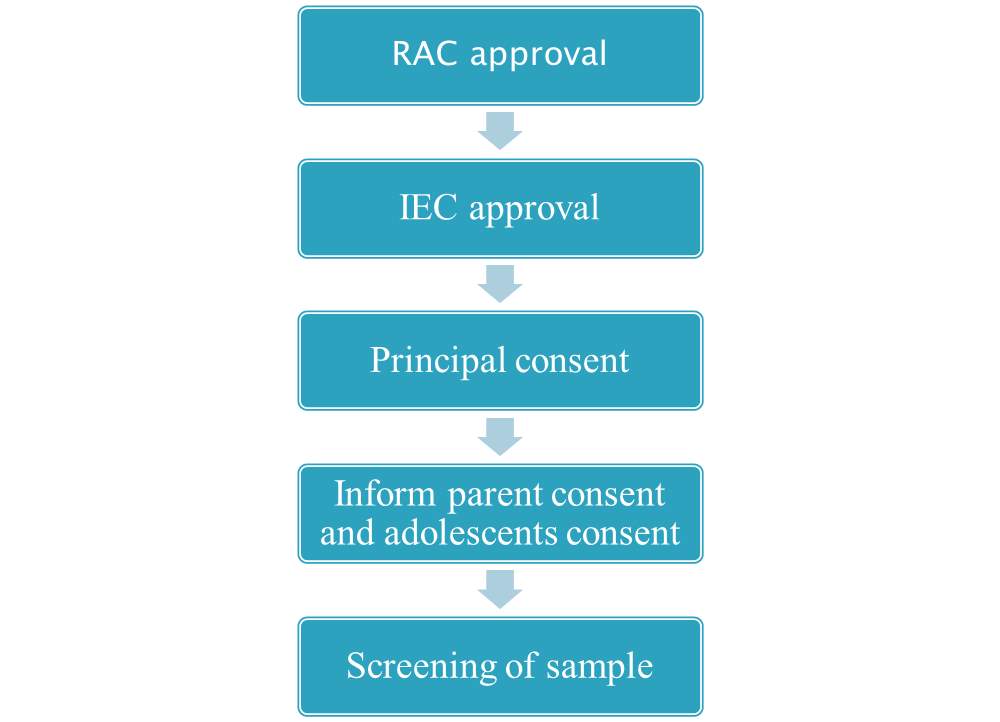
This study was approved by Research approval Committee (RAC). After that (IEC) Independent Ethics Committee approve this study.
Data collection procedure-
Before starting the collection of data, informed consent was undertaken from the principle of school, parents of the participants along with the adolescents. Data was collected during November and December month over period of time has two months. Before any data collection the participants has read consent form and also explain the topic of the study or objectives also each participant was interviewed for 30 minutes.
Data management-
Collected data was firstly entered in Ms- Excel sheet after that transfer in Statistical Package for Social Sciences (SPSS) version20 and anthroplus software used for calculating the BMI and BMI Percentile.
Chapter- 6
Result-
In this study total 100 participants has participated (50 girls and 50 boys). Mean age of the subject was 12.96 years
Frequency of the age-
| Age | Frequency | Percentage |
| 12 | 35 | 35 |
| 13 | 34 | 34 |
| 14 | 31 | 31 |
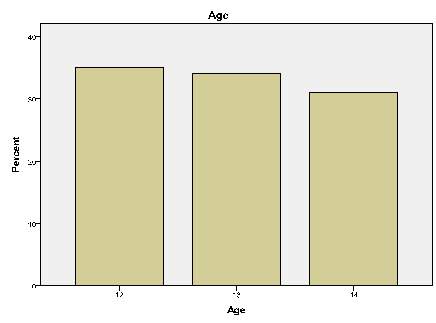
Frequency weight and height-
| Measurement | Mean | Standard deviation |
| Weight | 40.53 | 7.952 |
| Height | 152.21 | 6.678 |
On the basis of Category of BMI 34% participants are underweight, 59% are Normal weight, 67% are overweight.
| category of BMI | |||||
| Frequency | Percent | Valid Percent | Cumulative Percent | ||
| Underweight | 34 | 34.0 | 34.0 | 34.0 | |
| Normal | 59 | 59.0 | 59.0 | 93.0 | |
| Overweight | 7 | 7.0 | 7.0 | 100.0 | |
| Total | 100 | 100.0 | 100.0 | ||
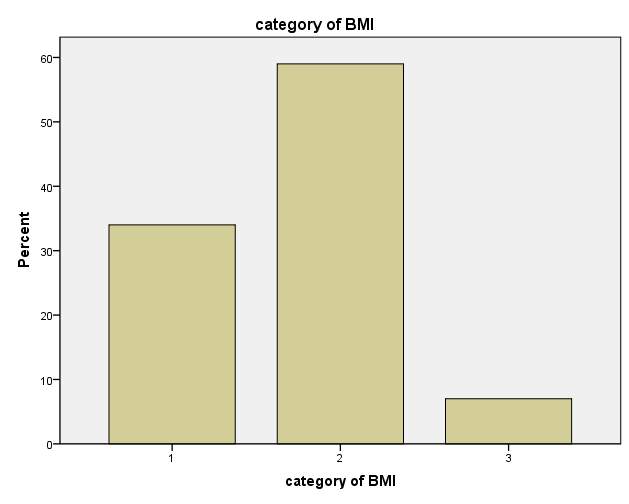
Underweight Normal Overweight
Weight perception behavior-
Body weight perception- Out of 100 participants half of the 64% participants has consider their weight is in normal, 14% participants consider their weight has too thin and 22% participants thinks they are fat. This analysis showed that more participants who perceived themselves as a fat they were not fat because as per category of BMI only 7 % participants are fat. 14% participants think they has too thin but actually they were thin because as per BMI category 34% participants are underweight. 64% participants were think they are normal category but actually 59% participants have normal weight.
| Do you consider yourself Too Thin, Normal, fat | |||||
| Frequency | Percent | Valid Percent | Cumulative Percent | ||
| Valid | Thin | 14 | 14.0 | 14.0 | 14.0 |
| Normal | 64 | 64.0 | 64.0 | 78.0 | |
| Fat | 22 | 22.0 | 22.0 | 100.0 | |
| Total | 100 | 100.0 | 100.0 | ||

Thin Normal Fat
Table- body weight perception
| Category of BMI | Consider yourself thin, normal, fat | χ² value | p value | ||
| Thin | Normal | Fat | |||
| Underweight
Normal Overweight |
92.9%
7.1% 0.0% |
31.3%
68.8% 0.0% |
4.5%
63.6% 31.8% |
52.331 | 0.00 |
In underweight category 92.2% participants described their thin, 31.3% as normal, 4.5% fat. 68.8% participants described their normal in normal BMI category. 63.6% normal weight participants described their weight as fat and 7.1% thin. Overweight participants are described self as fat only. They don’t perceive our self thin or normal.
Body image perception-
Half of the participants have a positive attitude about their body image perception means 79% participants have positive attitude. 18% participants have consider their body image has moderate. 3% participants were their body image perception in negative side.
| category of body image scoring | |||||
| Frequency | Percent | Valid Percent | Cumulative Percent | ||
| Negative | 3 | 3.0 | 3.0 | 3.0 | |
| Moderate | 18 | 18.0 | 18.0 | 21.0 | |
| Positive | 79 | 79.0 | 79.0 | 100.0 | |
| Total | 100 | 100.0 | 100.0 | ||
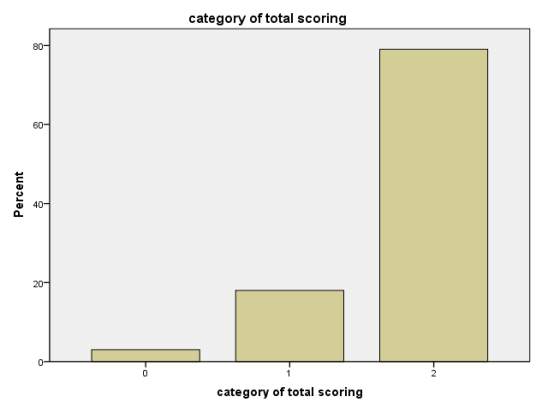
Negative Moderate Positive
|
|||||||||||||||||
| Questions | Category of BMI | Percentage | χ² value | p value | |||
| Yes | No | ||||||
| Concern about weight | Underweight
Normal Overweight |
36.3%
60% 3.7% |
25%
55% 20% |
6.699 | 0.035 | ||
| Friends talk about weight | Underweight
Normal Overweight |
31.3%
37.5% 31.3% |
34.3%
34.3% 28.6% |
17.366 | 0.00 | ||
| Body part which especially unattractive | Underweight
Normal Overweight |
39.3%
42.9% 17.9% |
31.9%
65.3% 2.8% |
8.586 | 0.014 | ||
| Bad feeling about body image | Underweight
Normal Overweight |
30.8%
46.2% 23.1% |
34.5%
60.9% 4.6% |
5.981 | 0.05 | ||
Out of 15 questions only 4 questions have significant result. Most of the participants have concern about their weight. Result of body image perception shown in Table-1. As many as 60% participants which they have normal weight but they have concerned about their weight, 3.8% participant has concerned about their weight but they have actually overweight, where as 36.3% has concern about weight. 37.5% participants who as normal in weight but they have peer about their friends talk about weight. 31.3% underweight and overweight participants have peer in mind. Normal weight participant have consider their body part which is especially unattractive 42.9%. 39.3% underweight participants have consider their body part has unattractive. 17.9% participants has think their body part which has unattractive. Overweight participants 23.1% have bad feeling about their body image. 30.8% participants who has underweight they also bad feeling about their body image. 46.2% normal weight participants have also bad feeling about their body image.
Graph no-1 Base on this graph participants are concerned about their weight a lot.

Graph no-2 Base on this graph participants think friends talk about their weight a lot
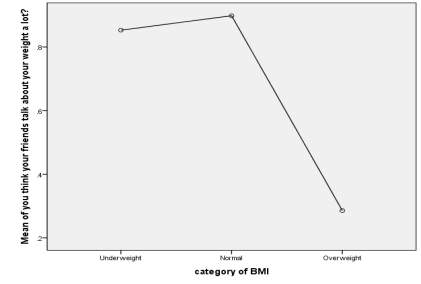
Graph No- 3 on the basis of this result participants are concerned about some body part which is unattractive.
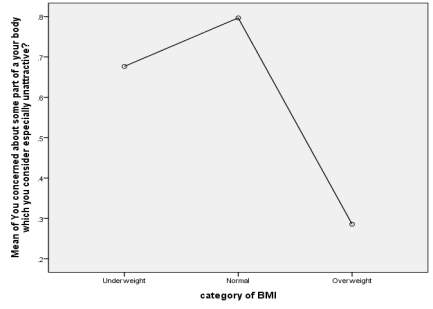
Graph no- 4 On the basis of this graph normal and underweight participants bed feeling about their body image.
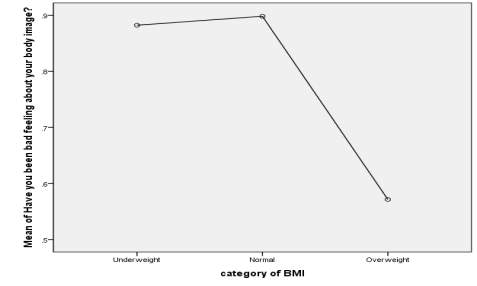
Dietary pattern-
Processed food and category of BMI are correlate with each other and some food items has significant. As per result consumption of confectionary food proved that 56% participants occasionally eat pastries. 75% participants eat occasionally burger and 48% participants have occasionally eat ice cream.
| Food item | Consumption | Percentage |
| Burger | Occasionally | 75% |
| Pastries | Occasionally | 56% |
| Ice cream | Occasionally | 48% |

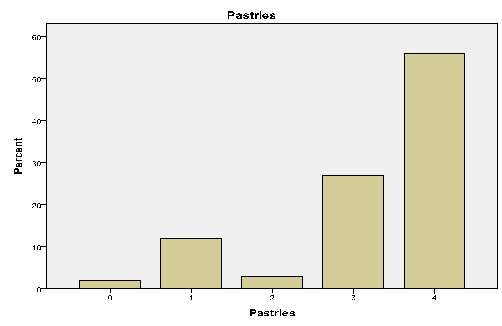
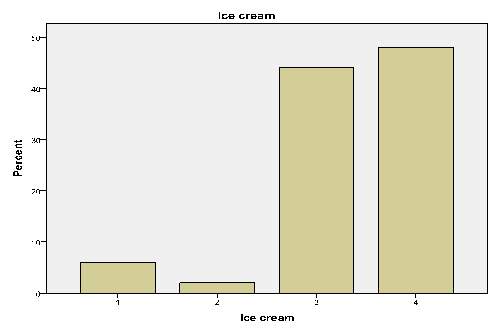
|
ANOVA |
||||||
| Sum of Squares | df | Mean Square | F | Sig. | ||
| Maggi | Between Groups | 3.658 | 2 | 1.829 | 1.303 | .276 |
| Within Groups | 136.132 | 97 | 1.403 | |||
| Total | 139.790 | 99 | ||||
| Pastas | Between Groups | 1.954 | 2 | .977 | 2.704 | .072 |
| Within Groups | 35.046 | 97 | .361 | |||
| Total | 37.000 | 99 | ||||
| Pizza | Between Groups | 1.691 | 2 | .846 | 2.109 | .127 |
| Within Groups | 38.899 | 97 | .401 | |||
| Total | 40.590 | 99 | ||||
| Chips | Between Groups | .270 | 2 | .135 | .077 | .926 |
| Within Groups | 170.640 | 97 | 1.759 | |||
| Total | 170.910 | 99 | ||||
| burger | Between Groups | 3.207 | 2 | 1.604 | 3.018 | .054 |
| Within Groups | 51.543 | 97 | .531 | |||
| Total | 54.750 | 99 | ||||
| cream paw | Between Groups | 5.678 | 2 | 2.839 | 2.435 | .093 |
| Within Groups | 113.072 | 97 | 1.166 | |||
| Total | 118.750 | 99 | ||||
| Pastries | Between Groups | 14.809 | 2 | 7.405 | 6.847 | .002 |
| Within Groups | 104.901 | 97 | 1.081 | |||
| Total | 119.710 | 99 | ||||
| Cookies | Between Groups | .108 | 2 | .054 | .020 | .980 |
| Within Groups | 257.602 | 97 | 2.656 | |||
| Total | 257.710 | 99 | ||||
| Samosa | Between Groups | .645 | 2 | .323 | .203 | .816 |
| Within Groups | 153.865 | 97 | 1.586 | |||
| Total | 154.510 | 99 | ||||
| Kachori | Between Groups | .839 | 2 | .420 | .231 | .794 |
| Within Groups | 176.071 | 97 | 1.815 | |||
| Total | 176.910 | 99 | ||||
| Panipuri | Between Groups | 4.118 | 2 | 2.059 | 1.110 | .334 |
| Within Groups | 179.922 | 97 | 1.855 | |||
| Total | 184.040 | 99 | ||||
| vadapaw | Between Groups | 2.975 | 2 | 1.487 | .988 | .376 |
| Within Groups | 145.985 | 97 | 1.505 | |||
| Total | 148.960 | 99 | ||||
| Ice cream | Between Groups | 6.419 | 2 | 3.209 | 5.557 | .005 |
| Within Groups | 56.021 | 97 | .578 | |||
| Total | 62.440 | 99 | ||||
Processed food correlate with category of BMI and result was significant-
Graph No 1- below graph shows that underweight and normal weight participants consume burger occasionally and result has significant (p 0.05)
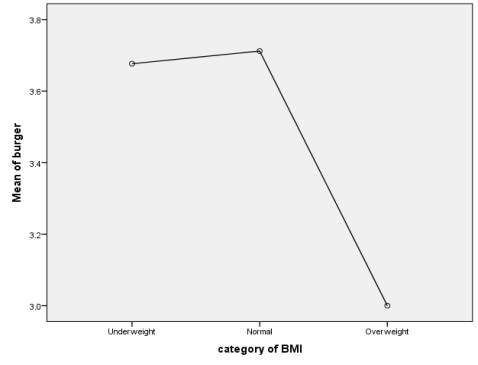
Graph No- 2 below graph shows that underweight and normal weight participants consume pastries occasionally and result has significant (p 0.002). This graph shows that underweight participants has less consumption of pastries.
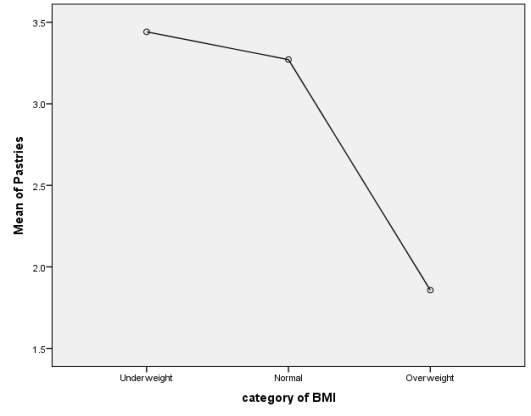
Graph No-3 below graph shows that underweight and normal weight participants consume occasionally and result has significant (p 0.005).
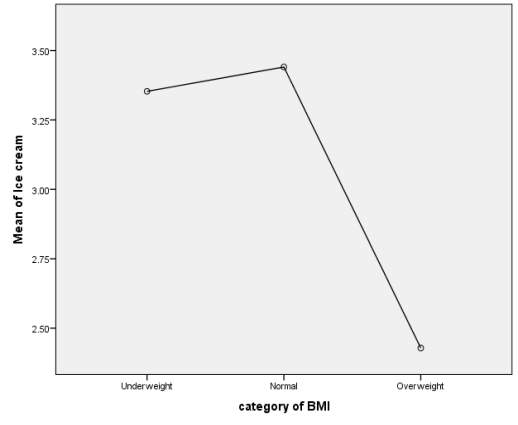
Some factors has not associated with any of the category of weight perception, body image perception or processed food that’s why these are not significant.
Chapter 7
Discussion-
In this study adolescents had consider their body as thin, normal and fat. Total 92.9% participants think they had underweight 31.3% adolescents think they had normal weight, 4.5% girls and boys were think they were fat. In normal category 7.1% participants had perceived their body weight has thin 68.8% as normal and 63.6% participants perceive themselves as fat. Their actual BMI and Perception of body weight is different 34% participants are underweight but 14% participants perceived their as underweight. 59% participants are normal weight but 64% participants themselves as normal weight. 7% participate has overweight but 22% participant perceived as overweight. Normal weight and underweight participant consuming processed food in higher amount. Keziah Joseph study shows that 38.2% adolescents had observed for dissatisfaction of the body areas. Number of significant girls (43.4%) was dissatisfied with their body weight than boys (38.2%). Lower satisfaction levels had lower torso, height and mid torso in girls, where as boys had lower satisfaction levels in mid torso and weight. Body weight perception describes how one perceives their body weight. Girls had higher score compare to boys suggest that girls have higher weight perception than boys. 34% girls think they are overweight as compared to boys 20%. Adolescents 25% normal weight and 30% underweight has misjudged their body size. Lucyna kapaka study shows that 54% participants described their body structure as normal, 23.7% as slim, 13.9% reported as overweight, 1.75 considered themselves as obese.
In this study more than half of the participants 79% adolescents had positive attitude about their body image perception and only 3% participants had negative attitude about their body image. Most of the student concern about their body image perception. They concern about their friends who talking about weight, they think about especial body part which is unattractive, they feel bad also about their body image.
Total 30% girl participants have peer about their perception 25.7% boys are leave in peer about body image perception. In this study adolescence consume some processed food in higher amount but not only overweight participants consume this food normal weight and underweight participants also consume this processed food. Vaishali R Deshmukh study shows that in higher amount of girls misperceived their body weight. Underweight and overweight boys and girls were unhappy with size and appearance of several body areas as compared to normal weight adolescents. Vaishnavi Ekbote study shows that majority of the public 81% were having normal body perception irrespective of their weight status. 50.5% adolescents were not concerned with their shape having normal BMI. 60.69% participants were not concerned but they come under healthy fitness zone. In Frederique R.E. Smink stud investigated whether confidence and peer status domains in early adolescence. Self esteem at age 11 and peer status at age 13 are associated with the level of eating pathology in young adulthood (Age 22). Lower self esteem and lower self perception and peer perception in the department of the social standing, academic competence and physical attractiveness in early adulthood. Nicole Taylor study shows that dissatisfaction of the body site means negative body image can result in dieting and engaged in exercise to change body shape and body size. In Jesus Roberto Garcia Sandoval study explained that majority of the participants are in normal weight. Adolescence belonging to the weight
Summary
The present study has to assess the weight and body image perception among the adolescence it is associate with each other and association occurs. Actual BMI and Perception is different. BMI calculate with the help of height and weight. Dietary pattern also associate with BMI with the help of FFQ so the consumption of proceeds food is higher in underweight and overweight participants.
Annexure
SUBJECT INFORMATION SHEET
Dear Participant,
This research is being undertaken for partial fulfilment of Masters Course in Nutrition and Dietetics at Symbiosis School of Biological Sciences.
The Title of the study is “To assess the weight perception and body image perceptions among adolescents (12-14 years) and its association with dietary pattern and body mass index”.
The purpose of the research is to find the weight perception, body image among adolescents and its correlation with dietary pattern and body mass index.
The data collected includes anthropometric measurements such as Height, Weight and BMI, Food Frequency Questionnaire, Multidimensional Body Self-Relation Questionnaire- Appearance Scale.
The information provided by you will be used for research purpose only and it won’t be used in any manner which would allow identification of your responses.
The study has been approved by institute research committee SSBS.
In case of any queries, please free to contact mob no. .
Yours Sincerely,
Name: Ms. RuchaPidadi
Symbiosis School of Biological Sciences
Contact no: 9766295958
Email id: rprucha24@gmail.com
INFORMED CONSENT
Title of the study:
Please tick (√) if you agree and (×) if you don’t agree.
|
|
I confirm that I have read and understood the informed consent form dated _____ for the above study and have had the opportunity to ask questions. | [ ] |
|
|
I understand that my participation in the study is voluntary and that I am free to withdraw at any time, without giving any reason, without my medical care or legal rights being affected. | [ ] |
|
|
I give my permission to the investigator of the study, others working on the Investigator’s behalf, the Ethics Committee and the regulatory authorities to look at my study records both in respect of the current study and any further research that may be conducted in relation to it, even if I withdraw from the study. I agree to this access. However, I understand that my identity will not be revealed in any information released to third parties or published. | [ ] |
|
|
I agree not to restrict the use of any data or results that arise from this study provided such a use is only for scientific purpose(s). | [ ] |
|
|
I agree to take part in the above study. | [ ] |
Participants Name: Participants Signature:_ _
Date: ____/___/____Time: _______
Investigators Name: Investigators Signature:
Date: ____/___/____Time: _______
Food frequency questionnaire-
| FOODS | Daily | 1-2 a week | 3-4 a week | 4-5 a week | monthly | Rarely | never | |||||
| Cereals-Rice | ||||||||||||
| Rice flakes | ||||||||||||
| Puffed rice | ||||||||||||
| Wheat | ||||||||||||
| Bread | ||||||||||||
| Pulses | ||||||||||||
| Toor dal | ||||||||||||
| Bengal gram dhal | ||||||||||||
| Green gram dhal | ||||||||||||
| Peas , green | ||||||||||||
| Rajmah | ||||||||||||
| Soyabean | ||||||||||||
| Leafy vegetables | ||||||||||||
| Amaranthus | ||||||||||||
| Cabbage | ||||||||||||
| Coriander | ||||||||||||
| Mint | ||||||||||||
| Shepu | ||||||||||||
| Spinach | ||||||||||||
| Root and tubers | ||||||||||||
| Beetroot | ||||||||||||
| Carrot | ||||||||||||
| Onion | ||||||||||||
| Potato | ||||||||||||
| Raddish | ||||||||||||
| Other vegetables | ||||||||||||
| French beans | ||||||||||||
| Brinjal | ||||||||||||
| Cauliflower | ||||||||||||
| Cucumber | ||||||||||||
| Capsicum | ||||||||||||
| Ladies finger | ||||||||||||
| Nuts | ||||||||||||
| Almonds | ||||||||||||
| Cashewnut | ||||||||||||
| Coconut | ||||||||||||
| Raisins | ||||||||||||
| Fruits | ||||||||||||
| Apple | ||||||||||||
| Banana | ||||||||||||
| Grapes | ||||||||||||
| Guava | ||||||||||||
| Lemon | ||||||||||||
| Mango | ||||||||||||
| Orange | ||||||||||||
| Papaya | ||||||||||||
| Sapota | ||||||||||||
| Tomato | ||||||||||||
| Egg | ||||||||||||
| Chicken | ||||||||||||
| Mutton | ||||||||||||
| Fish | ||||||||||||
| Milk and milk products –Milk | ||||||||||||
| Curd | ||||||||||||
| Buttermilk | ||||||||||||
| Cheese | ||||||||||||
| Paneer | ||||||||||||
| Fats and oils | ||||||||||||
| Oil | ||||||||||||
| Butter | ||||||||||||
| Ghee | ||||||||||||
| Sugar | ||||||||||||
| Jaggery | ||||||||||||
- No of servings per day
| Foods | 1-2 servings | 3-4
servings |
5-6
servings |
7-8
servings |
9-10 servings | No count | Never |
| Cereals-Rice | |||||||
| Rice flakes | |||||||
| Puffed rice | |||||||
| Wheat | |||||||
| Bread | |||||||
| Pulses- | |||||||
| Toor dal | |||||||
| Bengal gram dhal | |||||||
| Green gram dhal | |||||||
| Peas , green | |||||||
| Rajmah | |||||||
| Soyabean | |||||||
| Leafy vegetables | |||||||
| Amaranthus | |||||||
| Cabbage | |||||||
| Coriander | |||||||
| Mint | |||||||
| Shepu | |||||||
| Spinach | |||||||
| Roots and
tubers |
|||||||
| Beetroot | |||||||
| Carrot | |||||||
| Onion | |||||||
| Potato | |||||||
| Raddish | |||||||
| Other vegetables
French beans |
|||||||
| Brinjal | |||||||
| Cauliflower | |||||||
| Cucumber | |||||||
| Capsicum | |||||||
| Ladies finger | |||||||
| Nuts | |||||||
| Almonds | |||||||
| Cashewnut | |||||||
| Coconut | |||||||
| Raisins | |||||||
| Fruits | |||||||
| Apple | |||||||
| Banana | |||||||
| Grapes | |||||||
| Guava | |||||||
| Lemon | |||||||
| Mango | |||||||
| Orange | |||||||
| Papaya | |||||||
| Sapota | |||||||
| Tomato | |||||||
| Egg | |||||||
| Chicken | |||||||
| Mutton | |||||||
| Fish | |||||||
| Milk and | |||||||
| milk products – | |||||||
| Milk | |||||||
| Curd | |||||||
| Buttermilk | |||||||
| Cheese | |||||||
| Paneer | |||||||
| Fats and oils | |||||||
| Oil | |||||||
| Butter | |||||||
| Ghee | |||||||
| Sugar | |||||||
| jaggery |
Cite This Work
To export a reference to this article please select a referencing stye below:
Related Services
View allRelated Content
All TagsContent relating to: "Young People"
The term Young People often refers to those between childhood and adulthood, meaning that people aged 17-24 are often considered to be a young person.
Related Articles
DMCA / Removal Request
If you are the original writer of this dissertation and no longer wish to have your work published on the UKDiss.com website then please:




